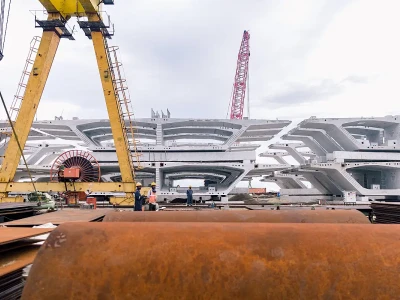
Platform leaves deep craters in Villimale reef
Photos released by EPA show four large craters in Villimale reef.
Top Stories
By
Najaah Masood
Environment Protection Agency (EPA) on Wednesday published photos of the damages caused to Villimale reef by the platform that ran aground on 16 August, with the photos showing four craters in the reef.
This Self Evaluating Platform (SEP) was used to drill boreholes required for the Greater Male Connectivity Project (GMCP) pillars, and it had gone adrift amid strong currents while it was being driven to be anchored to the main hull. The platform had run aground the outer Villimale reef, injuring three people on the platform when it crashed.
A week after the crash, local NGOs advocating for environmental conservation began protesting the delay in the dislodging of the platform, and the damage this delay could be causing to the reef. Lodged amid the sea rocks on the futtaru (the side of the island that does not have a beach and where the waves keep on crashing) side of the island, Villimale islanders said that the ceaseless impact of the massive platform crashing against the rocks can be both heard and felt throughout the island.
The platform was dislodged 11 days later, on 27 August. The eight days after that were spent on clearing away the underwater debris caused by the crash, and EPA managed to conduct their damage assessment after the cleanup was done.
While EPA had launched their survey on Tuesday in collaboration with the bridge contractor Afcons, they published the photographs taken by the divers who went under, depicting the large, deep craters in the reef. The survey is expected to take about two days.
EPA Director General Ibrahim Naeem told Dhauru Wednesday evening that the damage was not caused by the main hull of the platform, but by its spuds.
Photo observations:
-
Large craters visible, cut deep into the reef
-
One of the craters was deeper than the.
-
A diver went down into the crater and at his height, the crater was deeper than him, looking like a tunnel.
-
The reef was badly grazed by the platform’s anchor spuds.
The Bridge Office had previously reported that the anchor spuds of the floating barge-like platform had one of the lowered anchor spuds penetrated deep into the reef, and this was the main reason behind the delay in removal of the platform.
In the past, Maldives has experienced similar marine industrial crashes and sustained massive reef damages. The EPA had been there to investigate such incidents, make damage assessments, and even imposed fines on the responsible parties for the damage that had been caused, sometimes even charging the maximum fine penalty of MVR 100 million.
Afcons and the Bridge Office assures that this platform incident will not cause any delay in the project.




